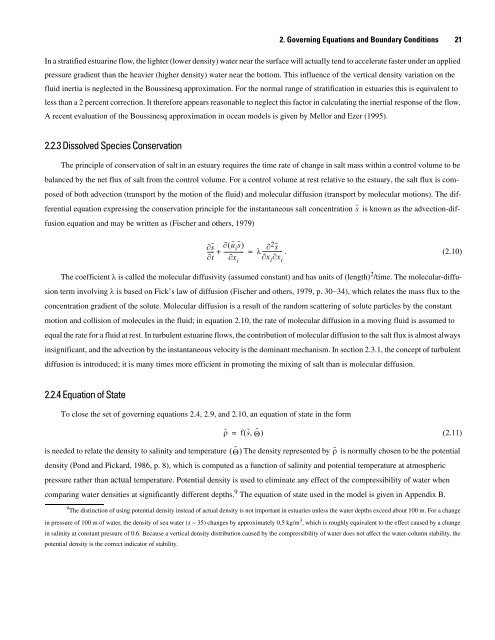A Semi-Implicit, Three-Dimensional Model for Estuarine ... - USGS
A Semi-Implicit, Three-Dimensional Model for Estuarine ... - USGS
A Semi-Implicit, Three-Dimensional Model for Estuarine ... - USGS
Create successful ePaper yourself
Turn your PDF publications into a flip-book with our unique Google optimized e-Paper software.
2. Governing Equations and Boundary Conditions 21<br />
In a stratified estuarine flow, the lighter (lower density) water near the surface will actually tend to accelerate faster under an applied<br />
pressure gradient than the heavier (higher density) water near the bottom. This influence of the vertical density variation on the<br />
fluid inertia is neglected in the Boussinesq approximation. For the normal range of stratification in estuaries this is equivalent to<br />
less than a 2 percent correction. It there<strong>for</strong>e appears reasonable to neglect this factor in calculating the inertial response of the flow.<br />
A recent evaluation of the Boussinesq approximation in ocean models is given by Mellor and Ezer (1995).<br />
2.2.3 Dissolved Species Conservation<br />
The principle of conservation of salt in an estuary requires the time rate of change in salt mass within a control volume to be<br />
balanced by the net flux of salt from the control volume. For a control volume at rest relative to the estuary, the salt flux is com-<br />
posed of both advection (transport by the motion of the fluid) and molecular diffusion (transport by molecular motions). The dif-<br />
ferential equation expressing the conservation principle <strong>for</strong> the instantaneous salt concentration s˜ is known as the advection-dif-<br />
fusion equation and may be written as (Fischer and others, 1979)<br />
∂s˜<br />
----<br />
∂t<br />
∂( ũis˜ )<br />
+ -------------- λ<br />
∂xi ∂2s˜ = -------------- . (2.10)<br />
∂xi∂x i<br />
The coefficient λ is called the molecular diffusivity (assumed constant) and has units of (length) 2 /time. The molecular-diffu-<br />
sion term involving λ is based on Fick’s law of diffusion (Fischer and others, 1979, p. 30−34), which relates the mass flux to the<br />
concentration gradient of the solute. Molecular diffusion is a result of the random scattering of solute particles by the constant<br />
motion and collision of molecules in the fluid; in equation 2.10, the rate of molecular diffusion in a moving fluid is assumed to<br />
equal the rate <strong>for</strong> a fluid at rest. In turbulent estuarine flows, the contribution of molecular diffusion to the salt flux is almost always<br />
insignificant, and the advection by the instantaneous velocity is the dominant mechanism. In section 2.3.1, the concept of turbulent<br />
diffusion is introduced; it is many times more efficient in promoting the mixing of salt than is molecular diffusion.<br />
2.2.4 Equation of State<br />
To close the set of governing equations 2.4, 2.9, and 2.10, an equation of state in the <strong>for</strong>m<br />
ρ˜ = f( s˜ , Θ˜ )<br />
(2.11)<br />
is needed to relate the density to salinity and temperature Θ ˜<br />
( )The density represented by ρ˜ is normally chosen to be the potential<br />
density (Pond and Pickard, 1986, p. 8), which is computed as a function of salinity and potential temperature at atmospheric<br />
pressure rather than actual temperature. Potential density is used to eliminate any effect of the compressibility of water when<br />
comparing water densities at significantly different depths. 9 The equation of state used in the model is given in Appendix B.<br />
9 The distinction of using potential density instead of actual density is not important in estuaries unless the water depths exceed about 100 m. For a change<br />
in pressure of 100 m of water, the density of sea water (s ~ 35) changes by approximately 0.5 kg/m 3 , which is roughly equivalent to the effect caused by a change<br />
in salinity at constant pressure of 0.6. Because a vertical density distribution caused by the compressibility of water does not affect the water-column stability, the<br />
potential density is the correct indicator of stability.

















